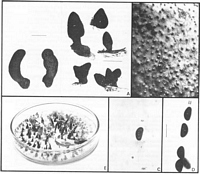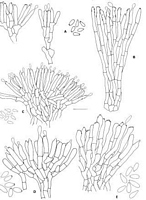|
 Xylaria cubensis Xylaria cubensis
SynonymsXylocoremium flabelliforme
Hypoxylon cubense
Sphaeria flabelliformis
Merisma nigripes
BiostatusPresent in region - Indigenous. Non endemic
Images (click to enlarge)
Caption: Fig. 1 Xylaria cubensis. A, Stromata (left: PDD 45340, right: PDD 49005). B, Surface of
stroma (PDD 49005). C, Ascal ring (Melzer's reagent, PDD 45340). D, Ascal ring and
ascospores (Melzer's reagent, PDD 49005). E, Colony on OA (PDD 49005) (Li | 
Caption: Fig. 6 Xylaria anamorphs A, B, X. castorea (A, conidiophores and conidia from culture
PDD 44288; B, conidiophores from nature PDD 44280). C, X. cubensis (from culture,
PDD 49005). D, X. tuberiformis (typical |
Description: Stromata: Stromata upright (taller than broad), or filiform; stipitate; apex rounded and fertile; 20-30 mm tall; 1 mm diam.; perithecia not visible; ostioles lower than or more or less equal to stromatal surface, or finely papillate; stromatal surface more or less smooth; dark brown (brown vinaceous), or blackish; KOH-extractable pigments lacking; tissue below perithecia conspicuous, essentially homogeneous, white.
Perithecia: Perithecia more or less globose; 0.5 mm diam.
Asci: Stipe long with spores more or less confined to upper third of ascus, or stipe long with spores more or less confined to upper half of ascus; amyloid ring broader than high.
Ascospores: Ascospores 8-10.5 µm long; 4-5 µm wide; brown; 0-septate; in side view inequilateral, flattened on one side, not curved; ends broadly rounded. Germ slit straight, spore-length. Perispore indehiscent in 10% KOH.
Article: Rogers, J.D.; Samuels, G.J. (1987) [1986]. Ascomycetes of New Zealand 8. Xylaria. New Zealand Journal of Botany 24(4): 615-650 (http://www.rsnz.org/publish/abstracts.php).
Description: Anamorph: Xylocoremium flabelliforme Rogers, Mycologia 76: 914. 1984.
Stromata unbranched, cylindrical, 2.5 cm long x 1 cm diam., base sometimes slightly
enlarged, pannose; entire fructification fertile; brown. Surface plane, crustose and hard, not
splitting but with network of fine cracks; perithecia completely immersed. c. 500 µm diam.,
opening through minute papillae; internal tissue solid (stromata often becoming hollow in
collections from elsewhere), white. Asci 160-180 µm total length x 6-7 µm, sporiferous
portion 50-70 µm, cylindrical; apical ring J+, minute, c. 2 µm wide x 1 µm high; 8-spored,
ascospores uniseriate with overlapping ends. Ascospores 8-10.5 x 4-5 µm, inequilateral with one side
flat to concave and the other side
round, elliptic in top view; brown, transparent; slit obscure, probably full length, parallel to
long axis of ascospore.
CHARACTERISTICS IN CULTURE: Colonies grown on OA 3 weeks at c. 20°C, 12 h
darkness/ 12 h near ultraviolet + cool white fluorescent light > 9 cm; mycelium appressed to
the surface of the agar, pale salmon; stromata forming throughout the colony. Stromata to 1.5
cm long x 3 mm diam., longest stromata in the middle of the colony, salmon but black at the
base, cylindrical except at the tip which is convoluted, conidiogenous. Conidia held in pale
grey, powdery masses. Conidiophores forming a compact 25-30 µm deep palisade, ±
penicillately branched 3-4 times, each branch 15-20 µm long, bearing refractive frilled scars
c. 0.5 gin diam. over the upper half of the cell. Conidia 4-5(-6) x 1.5-2.0 µm, clavate,
colourless, smooth; each with a flat, refractive, 0.5-0.7 µm wide basal abscission scar.
Habitat: HABITAT: On decaying wood of dicotyledonous trees.
Distribution: NORTH ISLAND: Northland, Auckland. Within New Zealand known
from two collections.
Notes: Xylaria cubensis is found in various tropical, subtropical, and temperate localities
of the world. Its systematics and biology have recently been discussed by Rogers (1984). It
has been confused with X. castorea and its allies (see notes regarding X. castorea).
|